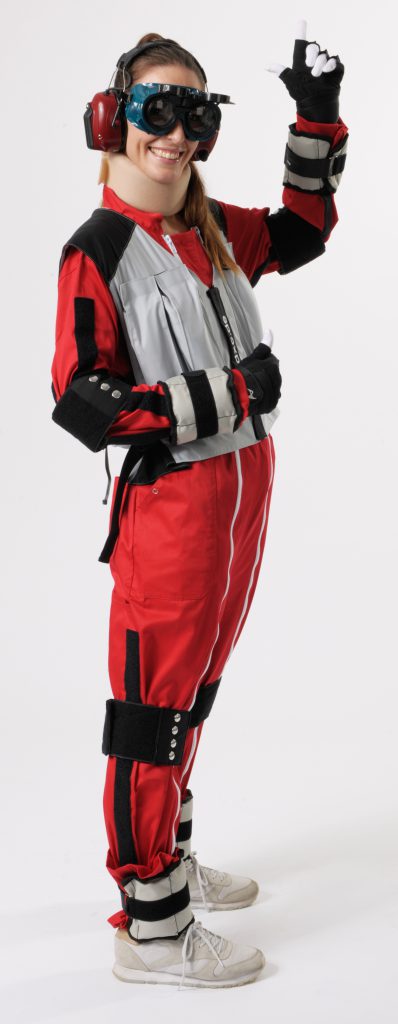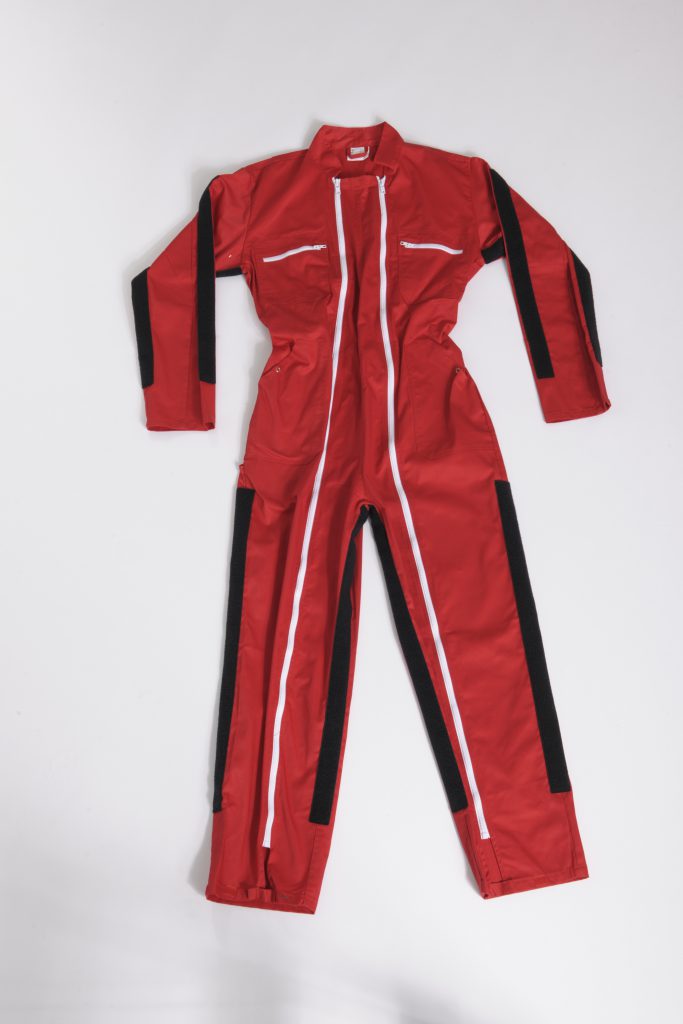The SD&C Senior
Suit Beta 3 allows the simulation of the effects of ageing to test the
usability of products and environments intended for use by the elderly. The
simulation restricts itself to the normal biological ageing process, while geriatric
diseases are excluded. The simulation includes the main effects of normal ageing,
as there are: less force, less movability, and deteriorated sensory detection
concerning vision, hearing, and the tactile sense.
The SD&C Senior
Suit Beta 3 includes the following parts:
- 1 special simulation optics
- 1 special electronic set of ear muffs including
batteries
- 1 transportation bag for optics and ear muffs
- 1 neck brace
- 1 transport bag
- 1 special jumpsuit with velcro stripes on the sides
- 1 special simulation vest
- 1 set of 9 body weights
- 1 pair of special wrist weights (1 kg)
- 1 pair of special ankle weights (1,5 kg)
- 1 pair of special elbow bandages (3 buttons)
- 1 pair of special knee bandages (4 buttons)
- 1 pair of white gloves
- 1 pair of short black wrist bandages
- 1 sheet of instructions
- 1 trolley carrying case with combination lock
Dress up procedure
The simulation will add about 30 to 40 years of age onto
the present age of a person, depending on the individual fitness. Not everybody is suitable to try this. The age of the test person should be between 15 and 60 years. Elder persons may try the simulation suit only, if they are sufficiently fit. Persons with deteriorated health, weak and pregnant persons should not try the simulation. The simulation should also not be applied to children, if their musculoskeletal system is still weak. Children normally are happily satisfied if they get the ear muffs on and are allowed to take a look through the simulation
optics. Over the age span between 15 and 25 years of age, the simulation has a stronger effect regarding physical force while having less effect regarding movability and sensory limitation. Best test results are achieved when different persons aged 20 to 40 years use the simulation suit and assessments are averaged.
Attention: Nobody must be shocked, depressed, or traumatized with age simulation!
- Dressing up starts with putting on the jumpsuit. Jackets
and pullovers should be dressed off and laid aside, shoes should be taken off. The
jumpsuit protects a person’s clothes, improves hygiene and allows an exact and
stable placement of the movement restriction. The size of the jumpsuit is
adjusted to the height of a person by turning over the sleeves as needed.
- The special vest is put on and the nine weights are
fitted into the pockets. The additional weight gives the test person a first
experience of what an additional weight means for the body, as with overweight.
For weaker than average persons weight pockets may be left empty. In addition
to the weight on the chest, the side strips at both sides of the vest may now
be used to further squeeze the upper body simulating breathing difficulties.
- Now the knee bandages (with four buttons) are put over
the knees. The plane side should be outside and the velcro side should be used
to fix the bandage right over the knee to the velcro stripes of the jumpsuit. The
knee-bandages simulate reduced movability. The knee bandages allow different
levels of restriction, however only light restriction should be applied to be
realistic. It is possible to put the bandages on while a person stands, but it
is also possible to do so with a seated person stretching out the leg for the
procedure. If a camping chair without arm rests is used, the person will later
be surprized how hard it is to put on the shoes again and to get up.
- The elbow bandages (with three buttons) are put on next
directly over the elbow joint. The bandages simulate the deteriorated
movability of the arms. The bandages are put on while the arm is stretched out.
They should be put on close to the arms, but should not be fastened too much.
Reaching over the head will be more difficult now, but should not be impossible.
- The heavier pair of weight bandages (1,5 kg) are now
attached above the ankles, but must still allow wearing shoes. These weights
simulate the reduced strength of the legs. Together with the weights in the
simulation vest, the effect can be best demonstrated when walking up stairs.
- The test person now receives the gloves to put them on
himself. The gloves simulate the reduced tactile sense. E.g. unpacking
medication or finding coins in a purse is becoming harder now.
- The short and fingerless wrist bandages can be put on
to simulate stiffer fingers of the basilar bones of the hand.
- Now the less heavy pair of weight bandages (1,0 kg) are
stripped around the lower part of the arms. It should be taken care that a wrist
watch does not hurt the test person. Together with the reduced arm movability
the test persons can now experience how much more difficult it is to reach out
and grip things needed.
- The neck brace is
put around the neck of the test person with the opening to the back. This
limits the degrees that the head can turn sideways, thus also limiting the
field of peripheral vision.
- The test person now
receives the simulation optics to put on himself. A test person’s own pairs of fragile
glasses should be put aside to a safe place, while the optics can be put over
stable glasses. The optics simulates the peripheral limitation of the field of
vision, a change in colour vision, a light macular degeneration and an increased
need for illumination. The visor allows the simulation of two stages, each
adding 20 years of age. The simulation should be started with the visorup,
simulating only 20 years of ageing. Thereafter the visor can be switched down
to simulate 40 years of ageing.
- Now the ear muffs
are put on. With increasing age hearing deteriorates, especially higher
frequencies are no longer heard by the elderly. With batteries included, the
lower turn button can switch on a tinnitus sound, that can be increased in
loudness, so that speech comprehension is deteriorated down to
misunderstandings.
- The dressing process
is now completed, and the SD&C Senior Suit Beta can now be used to assess
products and environments.
Small tasks can be
given that demonstrate the effects of being old, e.g. putting on shoes with
laces, walking stairs, reading text on medication, opening packages, operating
a cell phone or a hearing aid, getting a certain amount of money to pay out of
a purse. Tasks with liquids and those making the simulation suit dirty should
be avoided.
Every person in the simulation suit must be
accompanied for safety! The fast process of ageing without the normal years of
time for adjustment can lead to dizziness and faltering!
When using the age simulation suit for several days, the jumpsuit, the gloves and the neck brace should be washed at the end of every day. The jumpsuit and the gloves are machine washable, the neck brace should be hand washed. If necessary also the bandages and the vest can be washed. The ear muffs and the optics can be cleaned with a hygienic towel.
SD&C, January
2018



